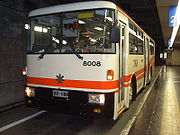
Tateyama Tunnel Trolleybus
Encyclopedia

Japan
Japan is an island nation in East Asia. Located in the Pacific Ocean, it lies to the east of the Sea of Japan, China, North Korea, South Korea and Russia, stretching from the Sea of Okhotsk in the north to the East China Sea and Taiwan in the south...
ese trolleybus
Trolleybus
A trolleybus is an electric bus that draws its electricity from overhead wires using spring-loaded trolley poles. Two wires and poles are required to complete the electrical circuit...
line in Tateyama
Tateyama, Toyama
is a town located in Nakaniikawa District, Toyama, Japan.As of 2003, the town has an estimated population of 28,123 and a density of 91.51 persons per km². The total area is 307.31 km².-External links:*...
, Toyama
Toyama Prefecture
is a prefecture of Japan located in the Hokuriku region on Honshū island. The capital is the city of Toyama.Toyama is the leading industrial prefecture on the Japan Sea coast, and has the industrial advantage of cheap electricity due to abundant water resources....
, operated by the Tateyama Kurobe Kankō Company. The line is entirely underground (in tunnel), including both termini. It is one of the only two trolleybus lines in Japan. The line is a part of Tateyama Kurobe Alpine Route
Tateyama Kurobe Alpine Route
The is a famous mountain sightseeing route between Tateyama, Toyama and Ōmachi, Nagano, Japan. The whole route opened on June 1, 1971.-Overview:The route is just 37 km in length, but the vertical interval is as large as 1,975m...
, together with another trolleybus line (the Kanden Tunnel Trolleybus
Kanden Tunnel Trolleybus
The is a Japanese trolleybus line between Ōgisawa Station, Ōmachi and Kurobe Dam Station, Tateyama. The line does not have any official name. The 6.1-km line runs almost entirely in a tunnel, except for about 300 metres at Ogisawa station and the approach to it. Opened in 1964, it is one of only...
line). The line originally opened as a normal (diesel) bus
Bus
A bus is a road vehicle designed to carry passengers. Buses can have a capacity as high as 300 passengers. The most common type of bus is the single-decker bus, with larger loads carried by double-decker buses and articulated buses, and smaller loads carried by midibuses and minibuses; coaches are...
line in April 1971, but was later re-equipped for trolleybuses. The trolleybus line opened on 23 April 1996.
Basic data
- Distance: 3.7 km (2.3 mi)
- Stations: 3
- Double-track line: None
- Electric supply: 600 VVoltThe volt is the SI derived unit for electric potential, electric potential difference, and electromotive force. The volt is named in honor of the Italian physicist Alessandro Volta , who invented the voltaic pile, possibly the first chemical battery.- Definition :A single volt is defined as the...
DCDirect currentDirect current is the unidirectional flow of electric charge. Direct current is produced by such sources as batteries, thermocouples, solar cells, and commutator-type electric machines of the dynamo type. Direct current may flow in a conductor such as a wire, but can also flow through... - Railway signallingRailway signallingRailway signalling is a system used to control railway traffic safely, essentially to prevent trains from colliding. Being guided by fixed rails, trains are uniquely susceptible to collision; furthermore, trains cannot stop quickly, and frequently operate at speeds that do not enable them to stop...
: Automatic signal system- Buses start while the signal is clear, and the number of vehicles is counted.
- Fleet: 8 trolleybuses, built in 1995–96 by Osaka Sharyo Kogyo (on Mitsubishi FusoMitsubishi Heavy Industries, or MHI, is a Japanese company. It is one of the core companies of Mitsubishi Group.-History:In 1870 Yataro Iwasaki, the founder of Mitsubishi took a lease of Government-owned Nagasaki Shipyard. He named it Nagasaki Shipyard & Machinery Works, and started the shipbuilding business on a full scale...
chassis), numbered 8001–8008.
See also
- Tateyama Kurobe Alpine RouteTateyama Kurobe Alpine RouteThe is a famous mountain sightseeing route between Tateyama, Toyama and Ōmachi, Nagano, Japan. The whole route opened on June 1, 1971.-Overview:The route is just 37 km in length, but the vertical interval is as large as 1,975m...
- List of trolleybus systems
- List of railway lines in Japan

